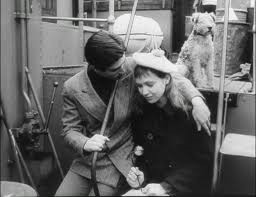foiled gangsters
by Douglas Messerli
Jean-Luc
Godard (screenplay, based on the fiction Fool’s Gold by Dolores and B.
Hitchens), Jean-Luc Godard (director) Bande à Part (Band of Outsiders
/ The Outsiders) / 1964
Godard’s most accessible film, Band of Outsiders (or The Outsiders) (1964) might almost be read, at moments, as a rechanneling of his friend, Truffaut’s Jules and Jim (1962), if he hadn’t already directed Breathless (1960), a far more artful study in “outsider” behavior. Of course, Truffaut also did something similar as early as his 1959 film The 400 Blows. In each case bad boys or young men pretending to be bad boys, all of them influenced far too much by American gangster movies and Hollywood Westerns, seek out trouble, taking their girlfriends along for the ride.
But then Godard—at least in my estimation—is a far more profound
thinker than Truffaut, and his “bad boys”—in this case Franz (the beautiful
Sami Frey) and Arthur (Claude Brasseur)—are, like Jean-Paul Belmondo in Breathless,
diffident decadents, unlike Truffaut’s more well-meaning and certainly more
well-intentioned delinquent child-men.
Although their famous “group” dance of
“The Madison,” might be perceived as an attempt to share Odile, it is also a
statement about their own shared commitments, not so very different from those
of Jules and Jim, who work out in the local gym together and are
known by nearly everyone as close “friends.”
In fact, I would argue, it is the open eroticism
of the ménage a trois relationships of both films—which put
their characters in the position of children playing seemingly infantile games
such as “house” or “doctor”—that allows us to accept the seeming “innocence” of
figures who might otherwise be perceived, particularly in the US, as petty
street thugs or outright villains. And it is their innocence which also
attracts them to the American films they act out, and which allows us to
perceive that they cannot tell the difference between fiction and reality.
Godard’s figures are loveable children, line-dancing in a local bar, racing to
beat the record of San Francisco’s Jimmy Johnson in racing through the great
French art museum, the Louvre, and openly flirting with Odile. And we can
hardly be so shocked by their determination to steal M. Stoltz’s unhidden
money, when he has stolen it, in turn, from the government in tax fraud.
But the consequences of his betrayal, a melodramatic shoot-out between Arthur and his uncle, which ends in both of their deaths, seems out of proportion to their foiled gangster-like misdeeds. Even if the outsider band think they have accidently killed Mme. Victoria, Godard’s long lensed camera reveals that she has survived the ordeal, and will now surely share in the reclaimed money with Stoltz.
As
Franz, moving on with Odile, proclaims, however, they too have not done so
badly. With Arthur out of the way, they can travel South on their way to
Brazil, knowing that, as Odile’s “love tube” reveals, Franz is able to make the
liquid flow her way.
Godard’s
figures understand themselves as fictional characters, whereas Truffaut’s
figures seem to forget the game they are playing and end up more tragically for
that fact. Band of Outsiders even announces that the
adventures of Franz and Odile will be portrayed in an all-color sequel—perhaps,
one might imagine, realized in his 1965 film Pierrot le Fou.
Los Angeles, January 16,
2016
Reprinted from World
Cinema Review (January 2016).






No comments:
Post a Comment